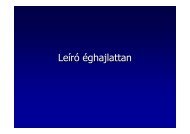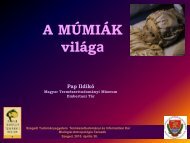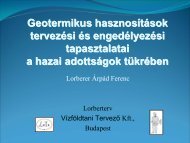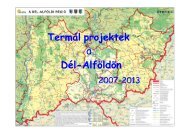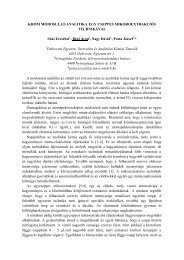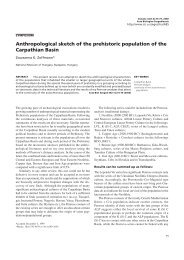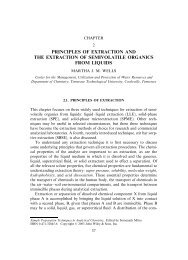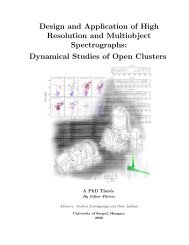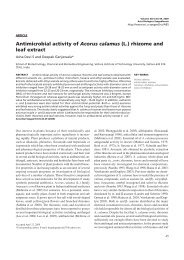Analysis of paternal genetic relationship of ancient Hungarian ...
Analysis of paternal genetic relationship of ancient Hungarian ...
Analysis of paternal genetic relationship of ancient Hungarian ...
You also want an ePaper? Increase the reach of your titles
YUMPU automatically turns print PDFs into web optimized ePapers that Google loves.
Our data suggest that the Tat C allele, which is widespread in Uralic-speaking<br />
populations, was present in the <strong>ancient</strong> Magyar population when they crossed the<br />
Carpathians and settled in the Carpathian Basin and the Tat polymorphism is an<br />
appropriate marker to investigate the <strong>ancient</strong> <strong>Hungarian</strong> gene pool.<br />
No one from the Archaeological Institute (excavator, anthropologist) who has handled<br />
the bones and nobody from our group has the Tat C mutation, which strongly supports<br />
the authenticity <strong>of</strong> the <strong>ancient</strong> DNA.<br />
In order to additional Y-chromosomal markers will be examined on <strong>ancient</strong><br />
remains in future studies the primer pairs for all studied markers in case <strong>of</strong> recent<br />
samples were redesigned or chosen from literature, resulting in shorter PCR products<br />
(below 170 bp), to serve the special needs <strong>of</strong> amplification <strong>of</strong> <strong>ancient</strong> DNA. We<br />
optimized and checked the PCR conditions <strong>of</strong> these primer pairs, so they are ready to<br />
use on <strong>ancient</strong> DNA.<br />
In case <strong>of</strong> the modern <strong>Hungarian</strong> and Szekler populations (in 197 individuals)<br />
twenty-two biallelic markers (M96, M89, M9, M45, M35, M78, M170, M253, P37,<br />
M26, M201, P15, M304, M267, M172, M102, M67, M92, Tat, M173, M17, M269)<br />
were examined in hierarchical order in agreement with the Y-chromosome phylogeny<br />
(Y Chromosome Consortium 2002, Jobling & Tyler-Smith 2003).<br />
All samples were surveyed for the M96, M89, M9 and M45 markers. These<br />
markers were typed by multiplex PCR followed by SNaPshot technique. Additional<br />
genotyping <strong>of</strong> samples was restricted to markers on the appropriate branch <strong>of</strong> the YCC<br />
haplogroup tree (Jobling & Tyler-Smith 2003). Markers M35, M78, M170, M253, P37,<br />
M26, M201, P15, M304, M267, M172, M102, M67, M92, Tat, M173, M17 and M269<br />
were analysed by the PCR-RFLP assay.<br />
In case <strong>of</strong> the <strong>ancient</strong> sample T2/41 out <strong>of</strong> four Y-chromosomal DNA fragments,<br />
containing the four basal markers (M96, M89, M9 and M45), the two shorter fragments<br />
(106 bp (marker M45) and 121 bp (marker M9) long specific PCR products) were<br />
successfully amplified. In case <strong>of</strong> these markers the ancestral C allele was typed. The<br />
ancestral state at marker M9 indicates that this sample could not carry the derived Tat C<br />
allele in accordance with Y-chromosome phylogeny (YCC 2002, Jobling & Tyler-Smith<br />
2003). This finding confirms the result <strong>of</strong> the PCR-RFLP analysis <strong>of</strong> this sample.<br />
The markers used allowed the classification <strong>of</strong> the modern samples into the E,<br />
F*, G, I, J, K*, N3, P* and R1 haplogroups.



